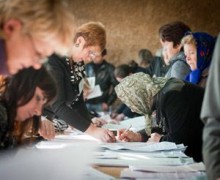So far we can only discuss the exit polls. The detailed results of the local elections will most likely be known in the next three days. But some patterns and tendencies can be identified already now.
Thus, the first conclusion of the elections: the Party of Regions is confidently moving westwards. Its overall support in the regions constitutes 36.2 percent. Representatives of the Party of Regions were elected to all regional councils of not only south-eastern Ukraine, but also in central and western Ukraine. The blue-whites took the first places in many traditionally “orange” regions — in Kyiv (23 percent), Cherkasy (27.2 percent), and Khmelnytsky (21.7 percent) regions; they also won with a big lead in the Kirovohrad region (40.9 percent). It is very likely that, taking into account the results at majority constituencies, the Party of Regions will become an absolute winner of the elections and will considerably increase the presence of its deputies in the majority of councils. Moreover, the Party of Regions will likely get its own mayors in cities with a population of one million or more. In all likelihood, these will be Odesa, Donetsk, and Dnipropetrovsk.
A second conclusion is the absolute victory of the All-Ukrainian Union Svoboda [Oleh Tiahnybok’s right-wing party – Ed.] in the three regions of western Ukraine. Of course, one can assume the situation with Batkivshchyna [Yulia Tymoshenko’s party – Ed.] deformed the electoral process in these regions. However, one cannot deny the obvious: voters are looking for a new opposition. As The Day already wrote, voting for Svoboda reflects not so much the growth of nationalistic sentiments as the radicalization of a part of voters, and the protest character of their voting. Now the All-Ukrainian Union Svoboda can expect a serious result at the elections to the parliament.
Hence, the third conclusion: the stagnation of Batkivshchyna. It still remains the main opposition force, it took the second place in the country, but the confidence in Batkivshchyna is not growing, on the contrary. However, for Batkivshchyna there are some successes too, notably the elections of its mayors in Kharkiv and Zaporizhia. In Kharkiv Arsen Avakov is leading in three exit polls out of four.
Volodymyr Lytvyn also became an outsider in the elections. It looks like voters understood the epithet “normal” as “none.” At the same time, the Communists, their colleagues in the coalition, improved their result. Overall, they took the fourth place.
The fourth conclusion is the success of Arsenii
Yatseniuk and the failure of Serhii Tihipko. They act in close ideological niches. But Tihipko entirely dissipated in the Cabinet of Ministers. Just as Tihipko himself, his party, Strong Ukraine, merged with the Party of Regions, sealing its faith. It is obvious that there is no need for a voter of Yanukovych to vote for Strong Ukraine if there is the Party of Regions.”
In the meantime, Yatseniuk worked on his mistakes and as a result entered with his own factions to most councils throughout the country. And this way he replaced Tihipko as the honorable third.
In fact, we now can observe how Yatseniuk and Tiahnybok together squeeze out Tymoshenko. People not disposed to vote for the radicals and for whom European values are closer voted for Yatseniuk.
The last and perhaps most important conclusion of these elections: the low turnout for the election and the growth of protest sentiments among voters. More than seven percent of voters did not support any party.







